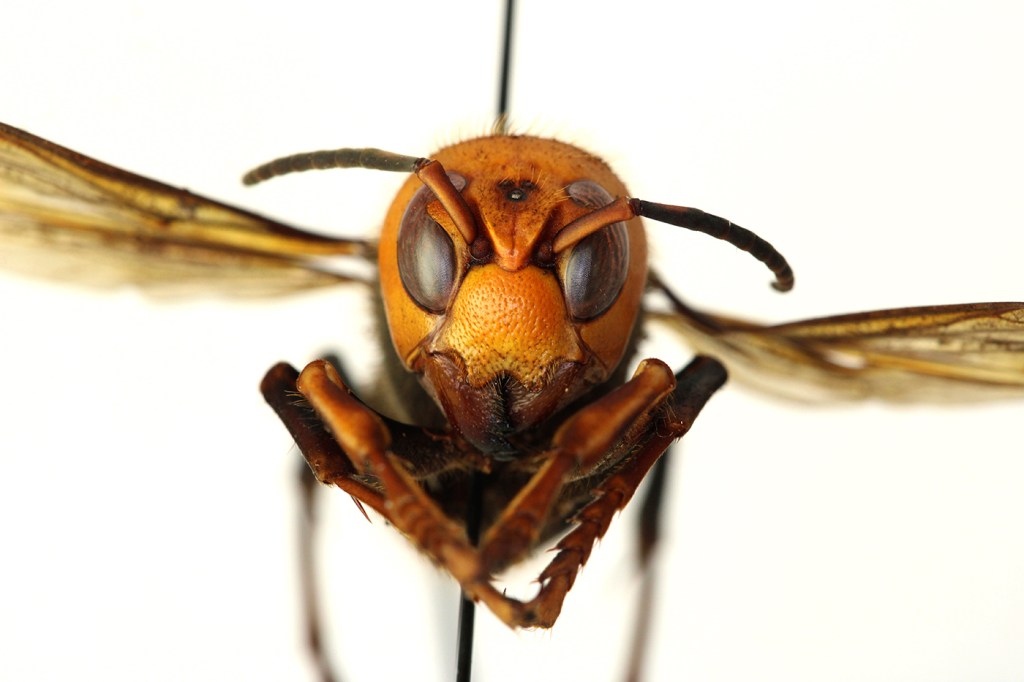The ‘murder hornet’ is out to get bees, not humans. So why are people still freaking out over it?

The wasp is huge, twice as large as other species. It’s got a long stinger, packs a venom that can be lethal to humans, and—let’s be honest—looks like a villain from a science fiction flick. And it recently showed up in the Pacific Northwest.
In recent weeks, the term “murder hornet” has generated temerous tweets and made for sensationalist headlines. But unless you’re a bee, the Asian giant hornet, which is not native to the U.S., is not trying to “murder” you. So why has social media been freaking out about it?
The answer may be fear itself, says Ajay Satpute, an assistant professor of psychology at Northeastern who studies fear and why it matters for social behavior.

Ajay Satpute is an assistant professor of psychology in the College of Science at Northeastern. Photo by Adam Glanzman/Northeastern University
Most people in the U.S. have not experienced the pain induced by the hornet firsthand or by learning from others’ accounts. But they can learn to fear something from certain visual and linguistic cues, and then their imaginations create that fear. Those cues include the sensationalist coverage that some media outlets gave the hornets, Satpute says.
“Most of it are static images and stories, and they use the terms ‘murder,’ or ‘attacking,’ or ‘killing,’” Satpute says. “It’s a really interesting question to see how we can create fears that are things that we’ve never experienced firsthand, and we haven’t necessarily observed even secondhand a direct experience of that, but are required in essence to imagine on the basis of language.”
In addition to a fear of the hornet’s stinger, there’s the fear of the unknown, which might be amplified by the idea that an unfamiliar species is entering people’s lives from a different part of the world. Unless someone is an expert in bugs and hornets, that person might feel afraid and unable to do anything about the hornets, Satpute says.
There’s also the feeling some people have toward insects in general, which might not be fear at all. Instead, Satpute says, people feel disgusted, worried and repulsed by the thought of coming into contact with a bug—a fear commonly referred to as “contamination worry.”
“In some cases, it’s not so much a fear of pain, but this sort of ‘contamination worry’ that people have towards insects,” Satpute says. “Some people who dislike spiders, for instance, express that more as disgust.”
Of course many people are at least somewhat primed for contamination worry by SARS-CoV-2, the coronavirus that has been stalking the world for months now. And whether or not other stressors are stacking and interacting with each other to worsen people’s fear of the hornets, the research suggests that minor stress factors could add up, Satpute says.
“There are multiple fears, multiple threats, that we’re bombarded with every day,” he says. “Even if they’re not themselves individually traumatic, chronic worries and anxieties can have some long-term impacts in our health.”
But back to the hornet, an oversized wasp native to southeast Asia that can behead entire colonies of honeybees, and may be a reason for alarm for beekeepers in Washington state, where two of the wasps were sighted last December. Entomologists think the two hornets, which were found dead, probably hitched a ride in a cargo ship from east or southeast Asia.
Because the giant hornets attack people only on the rare occasions when they are disturbed, entomologists have explained that people in the U.S. should not be afraid of the hornets. Still, during the days following headlines of the insect’s arrival, the buzz about a vicious new killer has led to people in the U.S. to mistakenly kill other species of large hornets and bees as they come out of hibernation.
As far as hornets go, nothing is larger than the Asian giant hornet, which grows to about two inches long. It sports an orange head, yellow-striped thorax, and ant-like jaws. Unlike other bees and wasps, it has a stinger that can penetrate standard beekeeper suits multiple times.
Because the Asian giant hornets are remarkably large, their sting is powerful enough to deliver several times the amount of pain and venom than other hornet species. People who have been stung by the giant hornet have described the pain as hot metal driving through the skin.
But, like other wasps, the giant hornets don’t generally attack people. And, according to scientists who study venom, on the rare occasions in which the giant hornet attacks people, it is a person’s allergic reaction to insect venom that is potentially lethal, not the power or dosage of the venom itself.
That’s one reason to think not all fear is bad.
Satpute says fear can play a functional role in society to handle different problems. Without fears toward certain circumstances, people and animals wouldn’t be motivated to take useful and corrective behaviors.
“You could even argue that panic might have some significance or utility to it when it comes to learning exactly the circumstances in which that mental state is important,” Satpute says.
For media inquiries, please contact media@northeastern.edu.





